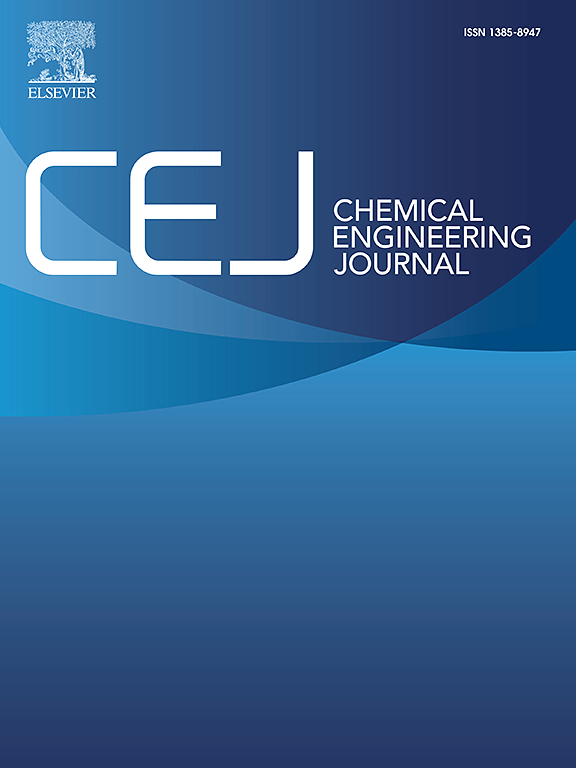Revealing the “double-layer ionic monotonic adsorption” electrochemical ion storage mechanism of nano-confined porous carbon
IF 13.2
1区 工程技术
Q1 ENGINEERING, CHEMICAL
引用次数: 0
Abstract
High voltage carbon-based capacitors used organic electrolytes show great potential due to high energy density, wide operating voltage, and long cycle stability. However, oxygen groups in carbon-based materials will undergo oxygen evolution reaction at high potential, leading to failure of the electrode material and triggering the decline of the capacitor. In addition, the ion storage mechanism of carbon-based materials in high voltage ionic liquids is unclear. Herein, we present a scalable method to synthesize three-dimensional porous flower-like carbon (3DPFC) composed of interconnected carbon sheets, highly interconnected pores, large specific surface area, low oxygen content from coconut shells using a simple bicarbonate activation method. Furthermore, combining in situ spectroscopy and theoretical calculations, a new “double-layer ionic monotonic adsorption” ion storage mechanism is revealed to be different from the conventional one, and the relationship between the pore structure and the ion storage behavior has been sublimely understood. As a result, the symmetrical supercapacitors using 3DPFC deliver an ultrahigh energy density (109 Wh kg−1) and high-power density (71 kW kg−1), retaining 94.1 % after 10,000 cycles at 10 A g−1. This study highlights the scalable production of high-capacity and low-oxygen-content carbon materials and offers insights into ion storage mechanisms for developing high-energy-density supercapacitors.


揭示了纳米约束多孔碳的“双层离子单调吸附”电化学离子储存机理
采用有机电解质的高压碳基电容器具有高能量密度、宽工作电压和长循环稳定性等优点,具有广阔的应用前景。然而,碳基材料中的氧基在高电位下会发生析氧反应,导致电极材料失效,引发电容器的衰退。此外,碳基材料在高压离子液体中的离子储存机制尚不清楚。本文提出了一种可扩展的方法,利用简单的碳酸氢盐活化法,从椰子壳中合成三维多孔花状碳(3DPFC)。3DPFC由互连的碳片、高度互连的孔、大比表面积、低氧含量组成。此外,结合原位光谱和理论计算,揭示了一种不同于传统的“双层离子单调吸附”离子储存机制,深刻理解了孔结构与离子储存行为之间的关系。因此,使用3DPFC的对称超级电容器提供了超高的能量密度(109 Wh kg−1)和高功率密度(71 kW kg−1),在10 a g−1下进行10,000次 循环后保持94.1% %。这项研究强调了高容量和低氧含量碳材料的可扩展生产,并为开发高能量密度超级电容器提供了离子存储机制的见解。
本文章由计算机程序翻译,如有差异,请以英文原文为准。
求助全文
约1分钟内获得全文
求助全文
来源期刊

Chemical Engineering Journal
工程技术-工程:化工
CiteScore
21.70
自引率
9.30%
发文量
6781
审稿时长
2.4 months
期刊介绍:
The Chemical Engineering Journal is an international research journal that invites contributions of original and novel fundamental research. It aims to provide an international platform for presenting original fundamental research, interpretative reviews, and discussions on new developments in chemical engineering. The journal welcomes papers that describe novel theory and its practical application, as well as those that demonstrate the transfer of techniques from other disciplines. It also welcomes reports on carefully conducted experimental work that is soundly interpreted. The main focus of the journal is on original and rigorous research results that have broad significance. The Catalysis section within the Chemical Engineering Journal focuses specifically on Experimental and Theoretical studies in the fields of heterogeneous catalysis, molecular catalysis, and biocatalysis. These studies have industrial impact on various sectors such as chemicals, energy, materials, foods, healthcare, and environmental protection.
 求助内容:
求助内容: 应助结果提醒方式:
应助结果提醒方式:


